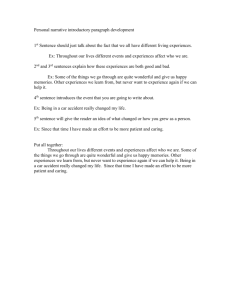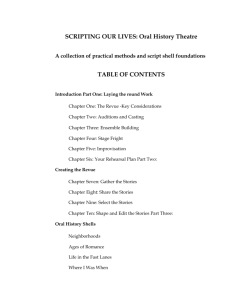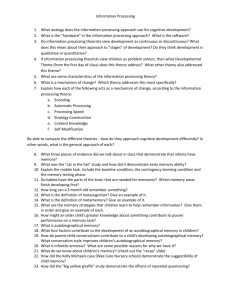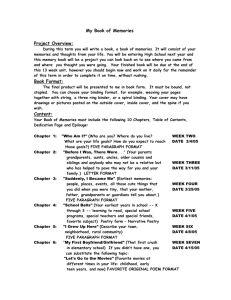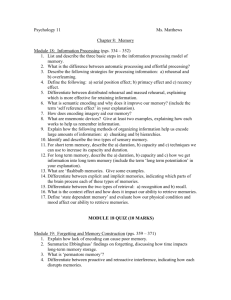ASSOCIATION FOR CONSUMER RESEARCH
advertisement
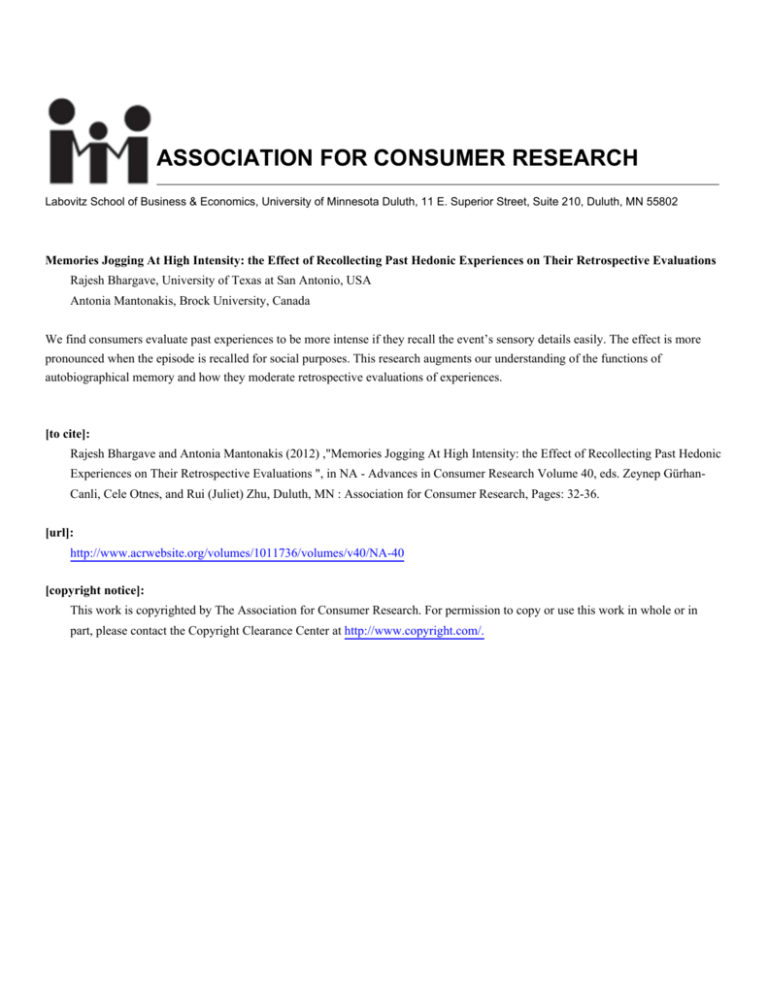
ASSOCIATION FOR CONSUMER RESEARCH Labovitz School of Business & Economics, University of Minnesota Duluth, 11 E. Superior Street, Suite 210, Duluth, MN 55802 Memories Jogging At High Intensity: the Effect of Recollecting Past Hedonic Experiences on Their Retrospective Evaluations Rajesh Bhargave, University of Texas at San Antonio, USA Antonia Mantonakis, Brock University, Canada We find consumers evaluate past experiences to be more intense if they recall the event’s sensory details easily. The effect is more pronounced when the episode is recalled for social purposes. This research augments our understanding of the functions of autobiographical memory and how they moderate retrospective evaluations of experiences. [to cite]: Rajesh Bhargave and Antonia Mantonakis (2012) ,"Memories Jogging At High Intensity: the Effect of Recollecting Past Hedonic Experiences on Their Retrospective Evaluations ", in NA - Advances in Consumer Research Volume 40, eds. Zeynep GürhanCanli, Cele Otnes, and Rui (Juliet) Zhu, Duluth, MN : Association for Consumer Research, Pages: 32-36. [url]: http://www.acrwebsite.org/volumes/1011736/volumes/v40/NA-40 [copyright notice]: This work is copyrighted by The Association for Consumer Research. For permission to copy or use this work in whole or in part, please contact the Copyright Clearance Center at http://www.copyright.com/. The Paradox of Memory Chair: Kathryn LaTour, Cornell University, USA Paper #1: Value of Memories Patrick Vargas, University of Illinois, USA factor that can distort memories—the act of recollecting an episode provides information on how memorable the experience was, which in turn can influence evaluations. Thus, while people value memories and seek to recollect past events, they may distort these memories each time they recall them in great detail. Nicole Votolato Montgomery will end by presenting her paper on the moderating role of brand commitment on false product experience memories. Hence, while the first two papers focus on the value attached to memories by consumers, the latter two papers focus on the malleability of these memories. The paper on brand commitment and false memories further highlights this paradox by demonstrating that consumers can be motivated through brand commitment to distort their memories. Paper #2: Nostalgic Charity Appeals: Moderating Effect of Mood, Beneficiary, and Childhood Icons Kathryn LaTour, Cornell University, USA Altaf Merchant, University of Washington, USA John B. Ford, Old Dominion University, USA Michael S. LaTour, Cornell University, USA Paper #3: Memories Jogging at High Intensity: The Effect of Recollecting Past Hedonic Experiences on their Retrospective Evaluations Rajesh Bhargave, University of Texas, USA Antonia Mantonakis, Brock University, Canada On The Often Outrageous Value of Memories Paper #4: Remembering the Best of Times or the Worst of Times? The Moderating Role of Brand Commitment on False Product Experience Memories Nicole Votolato Montgomery, College of William and Mary, USA Priyali Rajagopal, Southern Methodist University, USA Extended Abstract Try to recall your first kiss, or the time you bought your first car and drove it home. Now imagine that I am both willing and able to buy those memories from you. If you agree to sell me those specific, episodic memories those events will no longer exist in your mind; however, you will have cash money that I pay you, and you can do whatever you like with the cash. If a memory is particularly valuable to you, you would place a high price on it; if it is not valuable to you, you would place a low price on it. If it is a painful memory (e.g., your first heartbreak) perhaps you would even be willing to pay me to extract that memory. People asked to value their memories via this thought experiment placed astronomically high dollar values on their memories. In one study people averaged $1x1036 per memory. To put this into perspective, the wealthiest man in the world, Carlos Slim Helú, is estimated to be worth $74 billion, or 74x109. The number of atoms in the observable universe is estimated at 1080. Values in the neighborhood of $1036 are most likely symbolic, to be interpreted as “this memory is exceptionally important to me.” In a second study I asked people to constrain themselves, and I reminded them of Carlos Slim’s net worth. Even then, the mean dollar values for individual memories were around $5 million. By eliminating some of the ultra-high values I still ended up with mean values ranging from $11,000 to $1.9 million per memory. From these two simple studies I arrived at several tentative conclusions. First, people value their memories a lot. Second, there is remarkable variability in the extent to which people value their memories. The values placed on “memory of first heartbreak,” for example, ranged from $-1 million (i.e., willingness to pay me a million to remove the memory) to $100 million. Third, for negative memories, such as first heartbreak, there was a nearly symmetrical distribution of values around zero, suggesting that some people really value negative life events and others would much rather get rid of negative memories. This is an investigation of the extent to which, and reasons why, people feel that their memories of specific life events are valuable. What makes some memories more valuable than others? Inspired by Katz’s (1960) work on attitude functions, I propose several possible reasons why memories are so valuable. First, the commonly held illusion that our memories are accurate, like a video recorder (Simons & Chabris, 2011), probably accounts for some of the value people place on their memories. Memory is not like a video camera, it is Session Overview On one hand most Americans believe that “memory works like a video camera” (Simons & Chabris, 2011, p. 1) laying down representations of events that are accurate and accessible. Consumers value these memories enormously, and yet we know as consumer researchers that these memories to be highly malleable and subject to distortion. Broadly this session will be about this memory paradox. This session will contribute to the diversity call of the conference through these different views of memory and the role memory plays in consumer decision making. Marketers need to understand why consumers value memories if they want to build on them with their communication efforts as well as to what degree they can frame memories and at what point should they expect “push back” if their influence attempts become too apparent. In my own research I have studied the two extremes of this paradox-- how early childhood memories frame current preferences (Braun-LaTour, LaTour and Zinkhan 2007), and the fragility of these memories (Braun, Ellis and Loftus 2001). This session is designed to dig deeper into that memory paradox. While these papers were selected to highlight one side over the other (value vs. distortion), the paradox is implicit in all the work because if we didn’t value the memories, then having them distorted wouldn’t be important, nor would we value the memories as much if we thought they would never be forgotten. The session will start off with Patrick Vargas highlighting the extreme value consumers place on their memory experiences. He will discuss research he has done asking people to provide dollar values to certain memories and the astronomical numbers they attach to even negative experiences. Then Altaf Merchant will discuss some research we have done on nostalgic advertising and developing a nostalgic advertising scale. These studies look at how marketers can bank on the value of consumer memories but there are aspects, like icons, that they shouldn’t messed with when trying to appeal to the past, such as PBS’ move to promoting Cookie Monster as Veggie Monster. Then we move to the malleability side of things—Rajesh Bhargave will present his work looking at under what conditions memories are more positively recalled. This research identifies a basic 32 Advances in Consumer Research Volume 40, ©2012 Advances in Consumer Research (Volume 40) / 33 not accurate. Memory is reconstructive, and easily manipulated; our memories for life events are most likely full of large errors (Braun, Ellis & Loftus, 2002; Talarico & Rubin, 2003). If people learn that their memories are inaccurate, they should place lower values on them. People are not rational, and this prediction – that people would devalue their memories if they learned about the frailty of human memory – requires further empirical testing. Second, the valence of the memory matters; presumably happy memories would be worth more, on average, than aversive memories. So memories might be valuable to the extent that they help us to regulate our emotions. One surprising example of the importance of memory for emotion regulation is in a study of amnesiac patients v. “normal” controls. Both groups were shown a sad movie. Amnesiacs showed poorer recall of the film than controls; however amnesiacs showed greater persistence of sad feelings than controls because only the “normal” group was able to recall the sad film and attribute their sadness to the film (Feinstein, Duff, & Tranel, 2010). Third, some negative memoires might be valuable, if the memory represents some kind of lesson learned. If I no longer had the memory of getting food poisoning, I wouldn’t know to avoid eating Maryland crabs that had been sitting out in the sun all afternoon. Memories might be valuable because they serve a knowledge function (Katz, 1960; Shavitt, 1990). Fourth, and perhaps most importantly, people may feel that losing a valuable memory might somehow fundamentally change them. Our intuition is that our memories make us who we are; with a different set of memories, or minus a few critical memories, you or I might be a very different person. So memories might be valuable because they serve an essential, existential function. Related to this idea, people’s willingness to take enhancing drugs is inversely related to the extent to which that drug will affect a trait perceived as fundamental. For example, most everyone would benefit from being kinder, but only nine to ten percent of people would be willing to take a drug that improves kindness because kindness is perceived as a fundamental trait. On the other hand, 45-51 percent of people would be willing to take a drug that improves rote memory, because rote memory is not perceived as a fundamental trait (Riis, Simmons, & Goodwin, 2008). There may be other reasons we value memories, as well. This project will help us understand the psychology of selfperception and self-knowledge. References Braun, K.A., Ellis, R., and Loftus, E.F. (2002). Make my memory: How advertising can change our memories of the past. Psychology & Marketing, 19, 1–23. Feinstein, J. S., Duff, M. C., & Tranel, D. (2010). Sustained experience of emotion after loss of memory in patients with amnesia. Proceedings of the National Academy of Sciences, 1–6. Katz, D. (1960). The functional approach to the study of attitudes. Public Opinion Quarterly, 24, 163-204 Riis, J., Simmons, J. P., & Goodwin, G. P. (2008). Preferences for Enhancement Pharmaceuticals: The Reluctance to Enhance Fundamental Traits. Journal of Consumer Research, 35(3), 495–508. Shavitt, S. (1990). The role of attitude objects in attitude functions. Journal of Experimental Social Psychology, 26(2), 124–148. Simons, D. J., & Chabris, C. F. (2011). What people believe about how memory works: A representative survey of the U.S. population. PLoS ONE, 6(8), e22757. Talarico, J., & Rubin, D. (2003). Confidence, not consistency, characterizes flashbulb memories. Psychological Science, 14(5), 455. Nostalgic Charity Appeals: Moderating Effect of Memory Processing, Beneficiary, and Childhood Icons Extended Abstract Individuals donated about $217.8 Billion to charity in 2011. This represented about three quarters of all philanthropic giving (Giving U.S.A., 2012). Charitable organizations have increasingly realized that their fundraising communications need to have a credible and engaging message. Appeals to donate are often designed to emotionally stir consumers, attempting to influence their donations (Basil, Ridgway & Basil, 2008; Dillard & Peck, 2000). Some of the emotions that have been studied in the context of appeals for charities are sadness, anger, fear and guilt. Recently, Merchant, Ford and Rose (2011) found that nostalgia could be one of the reasons why people donate to charity. Moreover, Ford and Merchant (2010) and Zhou, Wildschut, Sedikides, Shi and Feng (2011) posit that nostalgia based fundraising appeals promotes charitable giving. Nostalgia has been found to influence preferences for certain products and services (Braun-LaTour, LaTour & Zinkhan, 2007). In a content analysis of a thousand U.S. television advertisements, Unger, McConocha and Faier (1991) found that nostalgia was used via theme, copy or music in ten percent of all of the U.S. advertisements analyzed. This reuniting of the individual with a longed-for past (Bassin, 1993) can be seen in the use of the songs of the 1960s and 1970s to evoke strong emotional connections with such products as automobiles, foods and beverages. It is a particularly promising mechanism for companies that claim a long and storied history since it is possible that multiple generations of consumers have past experiences that can be connected to happy periods in their lives which would potentially enhance their emotional orientation towards the company involved. In the current inquiry we add to the emerging research (Ford & Merchant, 2010; Merchant et al., 2011; Zhou et al., 2011) on the influence of nostalgia on charitable donations, by examining three boundary conditions of this effect. First, we argue that the effect of nostalgic charity appeals is moderated by the consumer’s memory processing. Next, we posit that they are more efficacious when consumers feel communal connections with the beneficiary of the charity. Lastly, we contend that nostalgic appeals work better when they evoke important consumer memories using childhood icons. In the first study we employed a 2X2 experimental design among 201 consumers. Attitude towards the ad (Aad) was the dependent variable; memory processing (personal/generic) and type of charity appeal (nostalgic/non-nostalgic) were the independent variables. The findings reveal that nostalgic appeals for charity work especially well when the consumer is primed with generic childhood memories. It appears than when the consumer is primed for personal childhood memories, he/she is any way emotionally engaged and hence even non-nostalgic ads perform as well. Belk (2010) postulates that when someone shares with family or the extended family, the act of sharing expands the sense of self for the individual; sustaining feelings of community with the receiver. Thus, past research has found that donors are more likely to donate to people with whom they can relate to and feel they have a communal relationship with (Small and Simonsohn, 2008). In study two we employed a 2X2 experimental design among 65 consumers. The dependent variable was Aad; the independent variables were communal connections with beneficiary of the donation (manipulat- 34 / The Paradox of Memory ed – high or low) and nostalgic memories evoked (measured-high or low). The findings reveal that when consumers feel that they have communal connections with the beneficiary of the charity, increasing nostalgic memories would result in higher attitudes towards the ad. Lastly, in study three, we argue that nonprofits can depend on the consumer’s nostalgic memories for raising donations but there are aspects, like icons, that they shouldn’t messed with when trying to appeal to the past, such as PBS’ move to promoting Cookie Monster as Veggie Monster. Here we employed a 2X2 experimental design among 67 consumers. The dependent variable was nostalgic memories evoked and the independent variables were ad character (manipulated – familiar or changed) and need to belong (measuredhigh or low) (Loveland, Smeesters and Mandel, 2010). The results from study three indicate that changing iconic characters of nonprofits may have an effect on how consumers process charitable appeals. This especially has an effect in the high need to belong consumers and tends to deflate the ability of the ad to evoke nostalgic memories. In summary, we build on recent research on the influence of nostalgia on charitable donations by suggesting more nuances to these effects. References Basil D., N. Ridgway & M. Basil, (2008), “Guilt and Giving: A Process Model of Empathy and Efficacy,” Psychology and Marketing, 25(1), 1-23. Bassin, D (1993), “Nostalgic Objects Of Our Affection: Mourning, Memory And Maternal Subjectivity,” Psychoanalytic Psychology, 10 (3), 425-436. Belk, R. (2010), “Sharing,” Journal of Consumer Research, 36, 715-734. Braun-LaTour, K., M. LaTour & G. Zinkhan (2007), “Using Childhood Memories to Gain Insight into Brand Meaning,” Journal of Marketing, 71, 45-60. Dillard, J. P., and E. Peck (2000), “Emotional Responses to Public Sector Announcements,” Communication Research, 27 (4), 461-495. Giving U.S.A. Giving USA Foundation Reports (accessed 14 February 2012), [available at http://www.givingusareports. org/) Ford, J.B. & A. Merchant (2010), “Nostalgia Drives Donations: The Power of Charitable Appeals Based on Emotions and Intentions,” Journal of Advertising Research, 50(4), 450-459. Loveland, K.E., D.Smeesters, & N.Mandel (2010), “Still Preoccupied with 1995: The Need to Belong and Preference for Nostalgic Products,” Journal of Consumer Research, 37(4), 393-408. Merchant, A., J. B. Ford & G.Rose (2011), “How Personal Nostalgia Influences Giving to Charity,” Journal of Business Research, 64(6), 610-16. Small, D. & U Simonsohn (2008), “Friends of Victims: Personal Experience and Prosocial Behavior,” Journal of Consumer Research, 35, 532-542. Unger, L. S., D.M. McConocha & J.A. Faier (1991), “The Use of Nostalgia in Television Advertising: A Content Analysis,” Journalism Quarterly, 68, 345-353. Zhou, X., T. Wildschut, C. Sedikides, K. Shi & C. Feng (2012), “Nostalgia: The Gift That Keeps on Giving,” Journal of Consumer Research, 39(1), 39-50. Memorability and Retrospective Evaluations: The Social Function of Autobiographical Memory in Evaluations of Experiences Extended Abstract Consumers are often prompted to remember details from past hedonic experiences. A patron may recollect a dish she ate at a restaurant in order to write a recipe. Alternatively, she may remember such details to share a story with a friend. We suggest that such reminiscence can impact the episode’s retrospective evaluations; if the event seems very memorable, it is evaluated at higher intensity. In our work, we also explore how the function of memory moderates the relationship between remembering the episode and its evaluations. Recently evoked information can contaminate consumers’ memories of past experiences through reconstructive processes. For instance, consumers incorporate information from post-experience advertising in their experiential memories (Braun, 1999). Imageryevoking ads can also produce false memories, whereby consumers mistakenly believe that they have experienced the advertised brand (Rajagopal & Montgomery, 2011). These results suggest that consumers’ memories are malleable, shaped by lay theories and inferences. We argue that people may form their inferences about past experiences on memorability itself. When a past event is recalled, the act of reminiscence provides new information: the subjective experience of ease or difficulty of remembering the event (Schwarz et al, 1991). Given that more intense experiences generally produce more vivid memories (Talarcio, LaBar, & Rubin 2004), consumers may learn the positive association between memorability and intensity across various experiential domains. As such, we predict that consumers will infer that if they can vividly recall the sensory details of a past experience, it was more intense. Thus, this inference is based on a lay theory concerning how memory operates. Importantly, although intense experiences are typically more memorable, other factors can influence the ability to remember a past episode, thereby dissociating this relationship. We further argue that this effect—inferring intensity from memorability—will be more pronounced when the memory is generated for social purposes—to communicate with others—and less pronounced for directive purposes—when using the past experience to guide one’s own future behavior (Bluck et al., 2005). The ability to recall an episode with vivid sensory details is more diagnostic for social uses of memory than directive uses, because describing the event to others requires concrete information to ensure a smooth and fluent interaction (Schlosser & Shavitt, 1999). Indeed, one of Grice’s (1975) conversational maxims is that speakers must be clear, avoiding obscurity—a principle served by retrieving specific sensory details when recalling a hedonic episode. We tested these predictions in three studies. In study 1, student participants (N = 69) engaged in a blind taste test of a wine through a series of sips. After a filler task, participants were asked to think about serving the wine at a future social gathering. Next, as a between-subjects manipulation of ease-of-retrieval for sensory details, they were asked to recall and write about either two sensory aspects about the wine—an easy task, or six such aspects—a more difficult task. The study also had a control condition in which participants did not recall any sensory aspects. They were then asked how interested and likely they would be in serving the wine at a social gathering and how successful and memorable it would be with guests. As predicted, ratings of intensity were higher when few sensory aspects (M = 5.64) were recalled versus no (M = 5.22) or many sensory aspects (M Advances in Consumer Research (Volume 40) / 35 = 5.22). Participants in the few sensory aspects condition also valued the wine $3 per bottle higher than the other two conditions. Notably, recalling six aspects was perceived to be more difficult than recalling two sensory aspects, consistent with an ease-of-retrieval effect. In study 2, mTurk participants (N = 133) were asked to retrieve a past autobiographical dining experience that took place between two weeks and two months ago. First, they wrote basic information about the experience: where they ate and who accompanied them on the meal. Next, they were asked to recall two, six, or no sensory aspects from the experience in a similar between-subjects manipulation of ease-of-retrieval as in study 1. They were then asked to rate the experience on its overall positivity, how much they enjoyed it, and how likely they would be to return to the restaurant. Ratings were higher in the few aspects condition (M = 6.32) than the many (M = 5.75) or no sensory aspects (M = 5.9) condition. Follow-up analyses revealed that the types of sensory aspects listed in the few and many conditions did not differ in their valence. However, writing more sensory aspects was perceived as more difficult. In study 3, we examined the role of memory function. We propose that the emphasis on either social versus directive functions of autobiographical memory can differ incidentally according to how people perceive themselves in relation to others when recalling a past episode. Study 3 (N = 166 mTurk participants) primed whether participants would construe themselves as primarily independent from others or interdependent with others after writing about the target experience (Trafimow et al, 1991). Examining our key dependent measures of perceived intensity, we found a significant ease-ofretrieval X self-construal interaction (p < .01); greater memorability enhanced perceived intensity in the interdependent self-construal condition, but not the independent self-construal condition. Taken together, our work offers new insights on the role of memorability in consumers’evaluations and the functions of autobiographical memory. References Bluck, S., Alea, N., Habermas, T., & Rubin, D. (2005). “A tale of three functions: The self-reported uses of autobiographical memory.” Social Cognition, 23(1): 91-117. Braun, K.A. (1999). “Postexperience advertising effects on consumer memory.” Journal of Consumer Research, 25, 319–334 Grice, P. (1975). “Logic and conversation”. In Cole, P. and Morgan, J. (eds.) Syntax and semantics, Vol 3. New York: Academic Press. Rajagopal, P. & Mongtomery, N.V. (2011). “I imagine, I experience, I like: The false experience effect.” Journal of Consumer Research, (38). Schlosser, Ann and Sharon Shavitt (1999), “Effects of an Approaching Group Discussion on Product Responses,” Journal of Consumer Psychology, 8 (4), 377–406. Schwarz, N., Bless, H., Strack, F., Klumpp, G., Rittenauer-Schatke, H., & Simons, A. (1991). “Ease of retrieval as information: Another look at the availability heuristic.” Journal of Personality and Social Psychology, 61:195–202. Talarcio, J., LaBar, K., & Rubin, D. (2004), “Emotional intensity predicts autobiographical memory experience.” Memory and Cognition, 32(7):1118–1132. Trafimow, D., Triandis, H.C., & Goto, S.G. (1991). “Some tests of the distinction between the private self and the collective self.” Journal of Personality and Social Psychology, 60, 649-655. Remembering the Best of Times or the Worst of Times? The Moderating Role of Brand Commitment on False Product Experience Memories Extended Abstract According to the reconstructive view of memory (Braun, 1999; Braun-LaTour et al, 2004), people may inadvertently recreate a recent experience (e.g., a visit to a favorite restaurant) by integrating information obtained from multiple sources, both internal (e.g., past experiences dining at the restaurant) and external (e.g. reviews of the restaurant, word of mouth from friends). Thus, consumers may erroneously recall entire experiences or details about experiences that did not occur. Such mistaken beliefs about an event are termed as false memories (Loftus 1997, 2003). We extend the literature on false memory by suggesting that consumers’ commitment to a brand moderates their false memories about that brand. Specifically, we show that brand commitment can both increase as well decrease the incidence of false memories, depending on the valence of the experience. Thus, highly committed consumers are less susceptible to the creation of negative false memories, but are more susceptible to the creation of positive false memories about prior brand experience. This is because negative experiences are likely to be atypical for high commitment consumers, thus lowering the plausibility of a false negative experience for these consumers. On the other hand, we suggest that positive and negative experiences are likely to be equally typical and hence, equally plausible for low commitment consumers. Therefore, low commitment consumers will not differ in their susceptibility to positive versus negative false memories. We find these effects of brand commitment across two different communication routes: advertising (study 1) and word of mouth (studies 2 and 3). Exposure to vivid experiential information either through marketing communications like advertising or exposure to vicarious experiences appear to result in memory distortion. In our first study we found that a significantly larger proportion of consumers who were highly committed to Pizza Hut (48.3%) reported having tried a fictitious brand variant (Pizza Hut “Naturals” pizza) than consumers who were not as committed to Pizza Hut (17.8%, χ2(1) = 6.12, p < .05). Further the highly committed consumers were also more confident in their false memories (3.97) than the low commitment consumers (2.36, t (102)= 2.93, p < .05). Thus, when the product experience was neutral/positive, highly committed consumers were more susceptible to the creation of false memories. In our second study, we found that consumers who were not highly committed to Subway reported higher negative false memories (2.2 on a 4-point scale) after exposure to vivid, negative online experience reviews, as compared to exposure to vivid and positive online reviews (1.6, t = 2.12, p < .05). Thus, low commitment consumers’ false memories varied with the valence of the reviews. On the other hand, consumers who were highly committed to Subway did not exhibit any significant difference in their incidence of false negative memories across exposure to negative (1.44) or positive reviews (1.77, t < 1). We also found that false memories impacted brand attitudes such that negative (positive) false memories lowered (increased) brand attitudes for the low commitment consumers, but not for the high commitment consumers. Thus, in addition to strategically using memories as a defense mechanism against vivid negative information, high commitment consumers are also unlikely to allow memories to change their favorable brand evaluations. Finally, a mediation analysis revealed that false memories mediated the effect of review valence on brand attitudes. 36 / The Paradox of Memory In our final study, we extend these findings from study 2 by documenting a similar pattern of results when the target brand varies across respondents (respondents selected the brand of athletic shoes they most preferred and were committed to) and a fictitious variant of the target brand is advertised (e.g., Nike Altra athletic shoes). Further, we examine the effect of commitment across several additional dependent measures including brand experience recall, the likelihood of other consumers’ negative experiences with the brand variant, brand variant quality assessment and brand variant purchase intentions, and find similar results across all these measures. We contribute to the false memory literature in several ways. First, we document a new moderator of false memory effects – brand commitment and show that brand commitment interacts with experience valence to affect the incidence of false memories. Second, we add to the emerging research on false memories in marketing (Lakshmanan and Krishnan 2009; Schlosser 2006) by exploring a previously unexamined route by which false beliefs about product experience may arise – word of mouth. Finally, we explore how the valence of presented information affects the nature of the false beliefs about past product experience and, hence, product evaluations. We also contribute to the literature on brand commitment by demonstrating that memory can be used as a strategic defense by highly committed brand consumers. Previous research has shown that highly committed consumers refute negative information through the generation of counterarguments and limiting the spillover of negative information to unrelated attributes (e.g. Ahluwalia et al. 2001). Our research suggests that highly committed consumers may also indulge in memory distortion to reduce the effect of negative brand information. References Ahluwalia, R., H. R. Unnava, & R.E. Burnkrant(2001)“The Moderating Role of Commitment on the Spillover Effect of Marketing Communications”Journal of Marketing Research 38, 458-471 Braun, Kathryn A. (1999), “Post-Experience Advertising Effects on Consumer Memory,” Journal of Consumer Research, 25(March), 319-334. Braun-LaTour, K. A., M. LaTour, J. E. Pickrell, & E. F. Loftus (2004), “How and When Advertising Can Influence Memory for Consumer Experience,”Journal of Advertising,33,7-25. Lakshmanan, A. & S. H. Krishnan (2009), “How Does Imagery in Interactive Consumption Lead to False Memory? A Reconstructive Memory Perspective,” Journal of Consumer Psychology, 19(3), 451-62. Loftus, E. F. (1997), “Creating childhood memories,”Applied Cognitive Psychology,11,S75-S86. Loftus, E. F. (2003), “Make-Believe memories,” American Psychologist, 58(11), 867-73. Schlosser, A. E. (2006), “Learning through Virtual Product Experience: The Role of Imagery on True versus False Memories,”Journal of Consumer Research, 33(3), 377-83.
